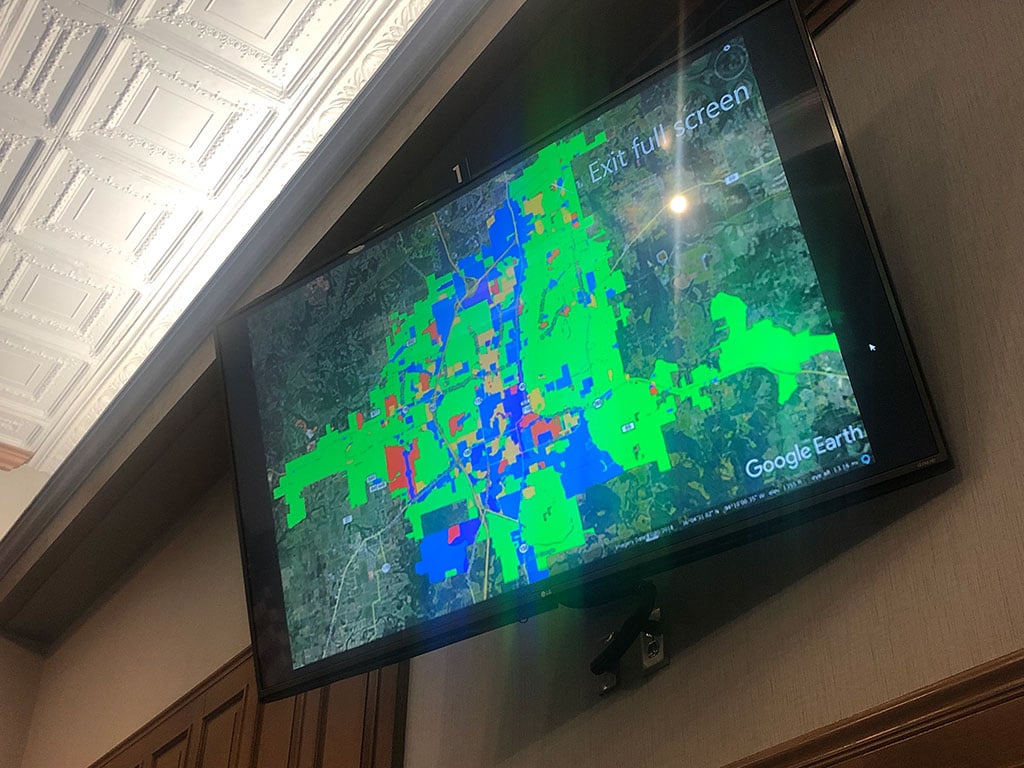
Officials are proposing smaller driveway widths on homes built on small lots inside two of the city’s nine single-family zoning districts. This image was presented as an example of a three-bedroom, two-bath home with a smaller driveway leading to a 2-car garage on the side of the house while still allowing for a front yard and a generous back yard.
City of Fayetteville
A proposal to limit driveway widths in certain neighborhoods with skinny lots drew a large crowd at Tuesday’s City Council meeting in Fayetteville.
Council members Sarah Marsh, Kyle Smith, Matthew Petty and Sloan Scroggin sponsored the proposed ordinace, which would limit driveway widths in front of single-family homes that are built in either of the city’s two single-family zoning districts that require buildings to be within a certain range of the road. In those two districts, the proposal limits driveway widths to the greater of 10 feet or 20% of the lot width.
The council made no decision on Tuesday, and instead agreed to revisit the discussion in two weeks. The delay would give city staff time to fine-tune the measure, but some council members said they hope the extra time could also provide an opportunity to help clear up some misconceptions.
In the preceding weeks, a petition was circulated by members of the Northwest Arkansas Board of Realtors that claimed the ordinance would reduce driveway widths regardless of the location or house size. “This means that the future of 2+ car garages is in jeopardy,” the petition stated.
By the time the proposal was up for discussion on Tuesday, the council chambers were packed to the edges as people lined the aisles and spilled out into the hallway, many who wore name tags and shirts indicating their affiliation with the board.
“There’s been a certain amount of confusion generated in the community over this,” said Smith, who invited Planning Commission chair Matt Hoffman to the podium to introduce the proposal.
Hoffman said Fayetteville has nine single-family zoning districts, and this change would only apply to new construction in two of them (RSF-18 and NC-Neighborhood Conservation). Together, those two zoning districts make up about 2.8% of the city in terms of acreage.

The parts of town that would be affected by the proposed new rule are represented in this map. The areas in red are where the changes would apply for new construction homes.
City of Fayetteville
Hoffman pointed to one of the city’s master plan goals which is to make traditional town form the standard. He said that goal cannot be reached without form-based codes. The city, he said, has seen success in the use of commercial and multi-family form-based developments and would like to see that success extended to single-family neighborhoods.
Hoffman said while some developers have chosen to build neighborhoods in form-based districts, the resulting construction does not resemble traditional town form at all. He showed example images of a neighborhoods built in the older RSF-8 district next to newer developments in the form-based NC district, and the two were nearly indistinguishable in their automobile-oriented streetscapes. He said the images are proof that NC is form-based in name only.
Restricting driveway widths would help solve that problem, Hoffman said, by allowing wider driveways on wider lots, and skinnier driveways on skinnier lots.
“It’s a pretty simple concept,” Hoffman said.
While driveway widths would be limited to 20% of the lot width, 10-foot driveways would be the bare minimum and would still be allowed even on the skinniest lots.
Hoffman showed examples of homes currently built in the city that have narrow driveways which lead to 2-car garages on the side of the house while still allowing for both a front yard and a generous back yard. He also pointed to homes in neighborhoods where 2-car garages are accessed from the backs of the homes, and where some homes share a driveway leading to two separate 2-car garages. All of those examples would be allowed and encouraged under the new proposal.

Hoffman showed this image of two neighborhoods – one built in an older zoning district (RSF-8) and one in a form-based district (NC) – that are nearly indistinguishable in design.
City of Fayetteville
During public comment, over a dozen people spoke against the proposal. Most referred to the suggestions made in the petition and cited all the reasons why they prefer houses with 2-car garages to those with one-car garages.
Don McNaughton, who is president of the NWA Board of Realtors, said he thinks homes with side-load driveways, shared driveways, and rear-facing driveways are not as desirable to homebuyers.
Others said the six-month grace period that’s proposed before the new rules go into effect isn’t long enough, including Steve Clark, president of the Fayetteville Chamber of Commerce.
Council member Sarah Bunch agreed, and said developers who are already in the process of designing and planning subdivisions would be at too big of a disadvantage to have the rules changed on them.
City Attorney Kit Williams said Bunch’s point is a good one, and told the council he’d like some time to research what the ideal time period would be before the new rules take effect.
Council member Smith admitted the proposal does need some amendments, and said he’d like to hold the item on the first reading, and even again in two weeks on the second reading to make sure the ordinance is the best it can be.
But, he said, time is of the essence in getting this change in place.
“What we’ve got here is a zone with unfulfilled promises, and it’s one of the ones that’s being developed most rapidly in a way that does not fit its intention,” Smith said.
He said a better way to implement the changes might be to identify a cutoff point in a development’s process timeline that would allow projects which are past that point to continue under the old rules.
“I don’t know what that point is tonight, and that’s why I would like to wait,” Smith said.
The discussion will continue at the next meeting on Oct. 15.

